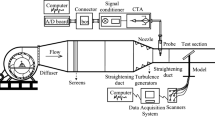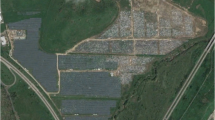Abstract
The complex three-dimensional flow that develops around an inclined flat solar panel near the ground is investigated using Computational Fluid Dynamics. The early stage evolution of the flow and the interaction of the shear layers emanating from the sides of the panel, the large separation region behind the panel and the boundary layers on the panel and ground are captured using Delayed Detached-Eddy Simulation to model the turbulence. The mean analysis shows that a small clearance produces a wall-jet like flow in the gap region between the panel and the ground, which tends to elongate the wake region in the downstream direction. On the other hand, a strong upwash is observed for a larger gap, reducing the length of the wake. Transient three-dimensional flow structures are captured using vorticity contours and the λ2-criterion. The early stage development of flow around the panel shows inverted hairpin-like vortices that are shed from the leading edge, touch down on the ground, generate a counter-rotating sheared vortex and a pair of vertical vortex tubes that extend from the ground and curl up into the wake. This pair of vortex tubes appears to be the source of the meandering structures reported in the literature. When the flow reaches a quasi-steady state, there is an asymmetric distorted flow for the smaller gap, whereas there is a nearly symmetric wake pattern for the larger gap.

















Similar content being viewed by others
Abbreviations
- CFD:
-
Computational Fluid Dynamics
- CFL:
-
Courant number
- CL :
-
Lift coefficient
- D:
-
Edge length, m
- DDES:
-
Delayed Detached-Eddy Simulation
- DES:
-
Detached-Eddy Simulation
- H:
-
Gap height, m
- k:
-
Turbulent kinetic energy, m2/s2
- L:
-
Length of the solar panel, m
- LES:
-
Large Eddy Simulation
- p:
-
Pressure, Pa
- RANS:
-
Reynolds-Averaged Navier–Stokes
- Sij :
-
Shear strain: \(\frac{1}{2}\left( {{\text{U}}_{{{\text{i}},{\text{j}}}} + {\text{U}}_{{{\text{j}},{\text{i}}}} } \right)\), s−1
- SIMPLE:
-
Semi-Implicit Method for Pressure Linked Equations
- SST:
-
Shear-Stress Transport
- t:
-
Time, s
- tr :
-
Reference time, s
- t*:
-
Normalized time, t/tr
- U, V, W:
-
Velocity components, m/s
- U(Y):
-
Streamwise velocity at the distance Y from the bottom wall, m/s
- Ug :
-
Velocity at gradient height Yg, m/s
- Ui, j :
-
Velocity gradients
- U0 :
-
Approaching velocity at the height of the inclined panel leading edge, m/s
- \(\overline{u}_{{{\text{rms}}}} ,\overline{v}_{{{\text{rms}}}} ,\overline{w}_{{{\text{rms}}}}\) :
-
Root mean square of velocity fluctuations, m/s
- uτ :
-
Frictional velocity, m/s
- W:
-
Width of the solar panel, m
- X, Y, Z:
-
Cartesian coordinate directions, m
- XAlt, YAlt :
-
Parallel and perpendicular axes to the inclined panel
- Y*:
-
Normal direction normalized by H for the gap region and Δ for the upper region
- Yg :
-
Gradient height in open terrain, m
- Y+ :
-
Wall normal distance: \(({\text{u}}_{{\uptau }} \cdot\ {\text{Y}})/{\upnu }\)
- α:
-
Constant exponent based on terrain type
- Δ:
-
Projected height of the inclined panel: W·sin(π − ϕ), m
- λ:
-
Eigenvalues
- ν:
-
Kinematic viscosity, m2/s
- ρ:
-
Air density, kg/m3
- τw :
-
Wall shear stress, Pa
- ϕ:
-
Inclination angle of the solar panel, deg
- Ωij :
-
Vorticity: \(\frac{1}{2}\left( {{\text{U}}_{{{\text{i}},{\text{j}}}} - {\text{U}}_{{{\text{j}},{\text{i}}}} } \right)\), s−1
- ω:
-
Specific dissipation rate, s−1
References
Bosch G, Kappler M, Rodi W (1996) Experiments on the flow past a square cylinder placed near a wall. Exp Therm Fluid Sci 13:292–305. https://doi.org/10.1016/S0894-1777(96)00087-8
Bosch G, Rodi W (1996) Simulation of vortex shedding past a square cylinder near a wall. Int J Heat Fluid Flow 17:267–275. https://doi.org/10.1016/0142-727X(96)00033-1
Straatman AG, Martinuzzi RJ (2003) An examination of the effect of boundary layer thickness on vortex shedding from a square cylinder near a wall. J Wind Eng Ind Aerodyn 91:1023–1037. https://doi.org/10.1016/S0167-6105(03)00050-3
Shi LL, Liu YZ, Sung HJ (2010) On the wake with and without vortex shedding suppression behind a two-dimensional square cylinder in proximity to a plane wall. J Wind Eng Ind Aerodyn 98:492–503. https://doi.org/10.1016/j.jweia.2010.03.002
Lee B-S, Kim T-Y, Lee D-H (2005) Control of vortex shedding behind a rectangular cylinder near the ground. Numer Heat Trans Part A Appl 47:787–804. https://doi.org/10.1080/10407780590921944
Li Z, Lan C, Ma Y (2012) Effects on dust emission from an inclined flat solar panel. In: ASME 2012 international mechanical engineering congress and exposition, Houston, Texas, USA, November 9–15, pp 619–624. https://doi.org/10.1115/IMECE2012-89463
Lan C, Jia L, Li Z, Ma Y (2013) Wall effect on separated flow around an inclined flat plate at high incidence. In: ASME 2013 international mechanical engineering congress and exposition, San Diego, California, USA, November 15–21, p 5. https://doi.org/10.1115/IMECE2013-65261
Shademan M, Balachandar R, Barron RM (2014) Detached eddy simulation of flow past an isolated inclined solar panel. J Fluid Struct 50:217–230. https://doi.org/10.1016/j.jfluidstructs.2014.06.024
Shademan M, Hangan H (2009) Wind loading on solar panels at different inclination angles. In: 11th Americas conference on wind engineering, San Juan, Puerto Rico, June 22–26
Shademan M, Hangan H (2010) Wind loading on solar panels at different azimuthal and inclination angles. In: The 5th international symposium on computational wind engineering, Chapel Hill, North Carolina, USA, May 23–27
Jubayer CM, Hangan HM, Siddiqui K (2014) Numerical and experimental investigations of wind flow around ground mounted solar panels. In: XIII conference of the italian association for wind engineering, Genova, Italy, June 22–25
Jubayer CM, Hangan H (2014) Numerical simulation of wind effects on a stand-alone ground mounted photovoltaic (PV) system. J Wind Eng Ind Aerodyn 134:56–64. https://doi.org/10.1016/j.jweia.2014.08.008
Higuchi H, Anderson RW, Zhang J (1996) Three-dimensional wake formations behind a family of regular polygonal plates. AIAA J 34:1138–1145. https://doi.org/10.2514/3.13204
Franke J, Hellsten A, Schlünzen H, Carissimo B (2007) Best practice guideline for the CFD simulation of flows in the urban environment. Quality Assurance and Improvement of Microscale Meteorological Models, Brussels, Belgium
Canadian Commission on Building and Fire Codes (2005) National building code of Canada 2005, vol 2. NRCC 47666. National Research Council of Canada, Ottawa, Ontario, Canada
Davenport AG, Isyumov N (1967) The application of the boundary layer wind tunnel to the prediction of wind loading. In: international research seminar: wind effects on buildings and structures, Ottawa, Canada, September 11–15, pp 201–230
Chen W-F, Lui EM (2005) Handbook of structural engineering, 2nd edn. CRC Press, Boca Raton
Engineering Sciences Data Unit (2002) Strong winds in the atmospheric boundary layer. Part 1: hourly-mean wind speeds. Engineering Sciences Data Unit, London, UK
Engineering Sciences Data Unit (2002) Strong winds in the atmospheric boundary layer. Part 2: Discrete gust speeds. Engineering Sciences Data Unit, London, UK
Versteeg HK, Malalasekera W (2007) An introduction to computational fluid dynamics: the finite method. 2 edn. Pearson Education Limited, UK
Nasif G, Barron RM, Balachandar R (2014) DES evaluation of near wake characteristics in a shallow flow. J Fluid Struct 45:153–163. https://doi.org/10.1016/j.jfluidstructs.2013.12.004
Nasif G, Balachandar R, Barron RM (2015) Characteristics of flow structures in the wake of a bed-mounted bluff body in shallow open channels. ASME J Fluids Eng 137:101207. https://doi.org/10.1115/1.4030537
Spalart PR (2009) Detached-eddy simulation. Annu Rev Fluid Mech 41:181–202. https://doi.org/10.1146/annurev.fluid.010908.165130
Spalart PR, Deck S, Shur ML, Squires KD, Strelets MK, Travin A (2006) A new version of detached-eddy simulation, resistant to ambiguous grid densities. Theor Comput Fluid Dyn 20:181–195. https://doi.org/10.1007/s00162-006-0015-0
Spalart PR (2006) Topics in detached-eddy simulation. In: Groth C, Zingg DW (eds) Computational fluid dynamics 2004. Springer Berlin Heidelberg, Berlin, Heidelberg, pp 3–12. https://doi.org/10.1007/3-540-31801-1_1
Menter FR, Kuntz M, Langtry R (2003) Ten years of industrial experience with the SST turbulence model. In: Hanjalic K, Nagano Y, Tummers M (eds) Turbulence, Heat and Mass Transfer 4: Proceedings of the 4th International Symposium on Turbulence, Heat and Mass Transfer, Antalya, Turkey, October 12–17. Begell House, Inc., pp 625–632
ANSYS (2013) ANSYS FLUENT theory guide. ANSYS Inc., Canonsburg, PA
Shur ML, Spalart PR, Strelets MK, Travin AK (2008) A hybrid RANS-LES approach with delayed-DES and wall-modelled LES capabilities. Int J Heat Fluid Flow 29:1638–1649. https://doi.org/10.1016/j.ijheatfluidflow.2008.07.001
Fukuda K, Balachandar R, Barron RM (2017) Development of vortex structures in the wake of a sharp-edged bluff body. Phys Fluids 29:125103. https://doi.org/10.1063/1.5003114
Fage A, Johansen FC (1927) On the flow of air behind an inclined flat plate of infinite span. Proc R Soc Lond Ser A 116(773):170–197. https://doi.org/10.1098/rspa.1927.0130
Hoerner SF, Borst HV (1985) Fluid-dynamic lift - practial information on aerodynamic and hydrodynamic lift. 2nd edn. Borst (Henry V) and Associates, Wayne, PA
Kim T-Y, Lee B-S, Lee D-H, Hwang J-H, Lee D-H (2003) A study on vortex shedding around a bluff body near the ground. In: SAE 2003 World congress and exhibition, Detroit, MI, USA, March 3–6. https://doi.org/10.4271/2003-01-0652
Kim T-Y, Lee B-S, Young-Whe P, Lee D-H, Lee D-H (2003) The study on a vortex shedding around square cylinders near a wall. In: 41st Aerospace sciences meeting and exhibit, Reno, Nevada, USA, January 6–9. https://doi.org/10.2514/6.2003-647
Nasif G, Balachandar R, Barron RM (2019) Influence of bed proximity on the three-dimensional characteristics of the wake of a sharp-edged bluff body. Phys Fluids 31:025116. https://doi.org/10.1063/1.5085666
Tobak M, Peake DJ (1982) Topology of three-dimensional separated flows. Annu Rev Fluid Mech 14:61–85. https://doi.org/10.1146/annurev.fl.14.010182.000425
Ohtsu I, Yasuda Y, Ishikawa M (1999) Submerged hydraulic jumps below abrupt expansions. J Hydraul Eng 125:492–499. https://doi.org/10.1061/(ASCE)0733-9429(1999)125:5(492)
Jeong J, Hussain F (1995) On the identification of a vortex. J Fluid Mech 285:69–94. https://doi.org/10.1017/S0022112095000462
Acknowledgements
This work was made possible by the facilities of the Shared Hierarchical Academic Research Computing Network (SHARCNET: www.sharcnet.ca) and Compute/Calcul Canada.
Author information
Authors and Affiliations
Corresponding author
Additional information
Publisher's Note
Springer Nature remains neutral with regard to jurisdictional claims in published maps and institutional affiliations.
Rights and permissions
About this article
Cite this article
Fukuda, K., Balachandar, R. & Barron, R.M. Analysis of the ground effect on development of flow structures around an inclined solar panel. Environ Fluid Mech 20, 1463–1489 (2020). https://doi.org/10.1007/s10652-020-09750-w
Received:
Accepted:
Published:
Issue Date:
DOI: https://doi.org/10.1007/s10652-020-09750-w




